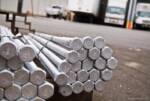What is the life span of the hot-dip galvanized coating of a bolt?
A common question when deciding whether hot-dip galvanizing is an adequate corrosion resistant coating for a fastener is, “How long will the galvanizing last before the steel begins to corrode?” The last thing you want to do is install a bolt in a corrosive environment, only to have it begin to rust a year later. Unfortunately there is not a straightforward answer to this question. There are many different variables to consider, given the countless applications that a galvanized bolt may be used for and environmental conditions it may be exposed to. One thing to keep in mind is that hot-dip galvanizing protects the fastener from corrosion and continues to do so with more success than most other coatings. A zinc plating could chip off and rust, but the hot dip galvanized coating bonds and penetrates the surface of the steel and will not chip or flake off over time.
 There are different elements that can make a difference in how long the galvanizing of a bolt will hold up, however the bolt’s environment is the main factor. A bolt is most susceptible to corrosion when it is exposed to the atmosphere. Depending on the climate, the hot-dip galvanized coating will react differently. Common climates requiring a galvanized coating include rain, snow, a marine environment, or even high heat, resulting in doses of prolonged sun exposure. The application of the bolt is also a major factor. For example, an anchor bolt may be embedded in soil, concrete, or even submerged in water. Since one environment is never equal to another, there isn’t any real way to determine how long the galvanizing will last. What we do know is that a galvanized fastener will withstand corrosion much longer than a bolt without any coating. According to the American Galvanizers Association, galvanized steel “corrodes at a rate of 1/30 of bare steel in the same environment.”
There are different elements that can make a difference in how long the galvanizing of a bolt will hold up, however the bolt’s environment is the main factor. A bolt is most susceptible to corrosion when it is exposed to the atmosphere. Depending on the climate, the hot-dip galvanized coating will react differently. Common climates requiring a galvanized coating include rain, snow, a marine environment, or even high heat, resulting in doses of prolonged sun exposure. The application of the bolt is also a major factor. For example, an anchor bolt may be embedded in soil, concrete, or even submerged in water. Since one environment is never equal to another, there isn’t any real way to determine how long the galvanizing will last. What we do know is that a galvanized fastener will withstand corrosion much longer than a bolt without any coating. According to the American Galvanizers Association, galvanized steel “corrodes at a rate of 1/30 of bare steel in the same environment.”
As stated, there really isn’t any way of knowing for sure how long the galvanized coating will last, but for optimal protection, it is important that the company performing the galvanizing is following a set of guidelines, such as ASTM F2329 or ASTM A153 Class C for galvanizing threaded fasteners, and ASTM A123 for iron and steel products, such as anchor plates. As an additional resource, there are organizations that have put together tools for predicting the estimated life span of galvanized steel given certain factors as well as the time frame for when a galvanized part should be maintained based on the thickness of the galvanizing, however these are strictly estimates and are not 100% accurate.
According to the American Galvanizers Association, hot-dip galvanized fasteners (assuming a minimum 2.5 mil coating thickness) in the following environments can expect the following minimum lifespan before time of first maintenance:
- Rural: 80+ years
- Suburban: 60+ years
- Temperate Marine: 55+ years
- Tropical Marine: 50+ years
- Industrial: 45+ years
Note: many galvanized fasteners have a far greater galvanizing thickness than 2.5 mils.
According to the American Galvanizers Association, it is common for large construction projects to have a 50-100 year design life. It is because of this that long-lasting corrosion protection is necessary. Hot dip galvanizing has been a method of protecting steel structures and their related fasteners by providing a superior barrier of protection from the surrounding elements. It is a proven method that has helped protect steel surfaces from corrosion in the harshest of environments. Although there is no real way of knowing the exact life span of a galvanized bolt or fastener, one thing we do know is that without it, the fastener will corrode and ultimately fail. Hot-dip galvanizing is an easy, cost effective way to ensure that your bolts are protected, regardless of its surroundings.
Portland Bolt is one of only a handful of bolt manufacturing companies in North America that not only manufactures nonstandard anchor bolts and construction fasteners, but also hot-dip galvanizes them within the same facility. Our ability to control the quality and the lead time makes us a great source for galvanized construction fasteners. Call us on your next project.


Good morning,
I am rebuilding my dock and bulkhead of a freshwater pond. I would like my dock built 6″ above the waterline to make it easier to get in and out of a kayak. This will put the supporting structure under water about 95% of the time. Will hot dipped galvanized lag bolts last very long submerged in a fresh water pond? The pond gets the normal annual treatments for algae, and is safe for swimming. I believe the water is on the hard side. Is this a bad idea?
Thank you,
Ted
@Ted- We are unable to quote you any specific lifespan expectations for these parts, but we can tell you that we sell a lot of hot dip galvanized parts to dock and marina contractors that work in both fresh and salt water.
Mr. Porreco,
I have heard that it is ill advised to mix mechanically galvanized hardware with hot dipped galvanized hardware. Any truth to this? If so, what are the implications of possible failure? What about mechanically galvanized hardware coming in contact with a hot dip galvanized part…any issues?
Thanks
TC
@Tom- The issue is not with the two coatings coming into contact with each other – they are chemically almost identical. The issue is with the bolts and nuts and how they mate together. Bolts, regardless of coating, are threaded and then coated. The main difference is with the nuts. Hot dip nuts are coated and then tapped, whereas mechanically galvanized nuts are tapped and then coated. If you try to mate a hot dip bolt with a mechanical nut, they will not mate properly and vice versa with a mechanical bolt and hot dip nut. That is the crux of the issue. The washer will make no difference, there is no prohibition regarding mixed coating with washers.